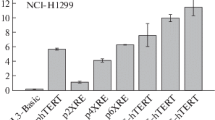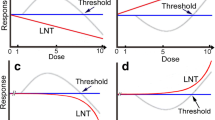Abstract
The effect of the tumor promoters 12-O-tetradecanoylphorbol-13-acetate (TPA), mezerein, teleocidin, anthralin, the Ca2+-ionophore A23187, butylated hydroxytoluene (BHT), dichlordiphenyltrichloroethane (DDT) and phenobarbital (PB) on lucifer yellow transfer in cultures of SV-40-transformed Djungarian hamster fibroblasts was studied. TPA, mezerein, teleocidin, A23187, DDT and BHT exerted a strong inhibitory effect on cell-to-cell dye transfer. Anthralin uncoupled cells in 3 experiments out of 6. PB appeared to enhance lucifer yellow transfer. Sodium nitrite, a substance with unknown promoting activity, effectively uncoupled cells. All the promoters investigated had a reversible effect on the dye transfer. The value of the dye transfer method for promoter screening is discussed.
Similar content being viewed by others
Abbreviations
- BHT:
-
butylated hydroxytoluene
- DDT:
-
dichlordiphenyltrichloroethane
- LY:
-
Lucifer Yellow
- PB:
-
phenobarbital
- TPA:
-
12-O-tetradecanoylphorbol-13-acetate
References
BÖRZSÖNYI, M., TÖRÖK, G., PINTER, A. and SURJÁN, A. (1984). Agriculturally-related carcinogenic risk. In: Models, mechanisms and etiology of tumor promotion (M. Borzsonyi, N.E. Day, K. Lapis and H. Yamasaki, eds.). IARC Sci. Public. No. 56, pp. 465–487, IARC, Lyon.
BERKINBLIT, M.B., BOZHKOVA, V.P., BOITSOVA, L.Y., MITTELMAN, L.A., POTAPOVA, T.V., CHAILAKHJAN, L.M. and SHAROVSKAYA, YU. YU. (1981). High-permeability contact membranes. Nauka, Moscow, pp. 1–464 (In Russian).
BUDUNOVA, I.V., MITTELMAN, L.A., BELITSKY, G.A. and CHAILAKHJAN, L.M. (1986). Inhibitory effect of tumor promoters on the Lucifer Yellow intercellular exchange in culture of transformed Djungarian hamster fibroblasts. Doklady Acad. Sci. USSR 290:1334–1338.
CASTAGNA, M., TAKAI, Y., KAIBUCHI, K., SANG, U., KIKKAWA, U. and NISHIZUKA, Y. (1982). Direct activation of calcium-activated phospholipid-dependent protein kinase by tumor promoting phorbol esters. J. Biol. Chem. 257:7847–7851.
CHIDA, K., KATO, N. and KUROKI, T. (1986). Down regulation of phorbol diester receptors by proteolytic degradation of protein kinase C in a cultured cell line of fetal rat skin keratinocytes. J. Biol. Chem. 262:13013–13018.
DIAMOND, L., O'BRIEN, T.G. and BAIRD, W.M. (1980). Tumor promoters and the mechanism of tumor promotion. In: Advances in Cancer Research 32:1–74.
ELMORE, E., KORYTYNSKI, E.A. and SMITH, M.P. (1985). Tests with Chinese hamster V79 inhibition of metabolic cooperation assay. In: Progress in mutation research (J. Ashby, F.J. de Serres et al., eds.), Vol. 5, pp. 597–612. WHO. Elsevier Sci. Publ., Amsterdam.
ENOMOTO, T. and YAMASAKI, H. (1985). Phorbol ester-mediated inhibition of intercellular communication in BALB/c 3T3 cells: relationship to enhancement of cell transformation. Cancer Res. 45:2681–2688.
FITZGERALD, D.J., KNOWLES, S.E., BALLARD, F.J. and MURRAY, A.W. (1983). Rapid and reversible inhibition of junctional communication by tumor promoters. Cancer Res. 43:3614–3618.
FRIEDMAN, E.A. and STEINBERG, M. (1982). Disrupted communication between late-stage premalignant human colon epithelial cells by 12-O-tetradecanoylphorbol-13-acetate. Cancer Res. 42:5096–5105.
FUJIKI, H., TANAKA, Y., MIYAKE, R., KIKKAWA, Z., NISHIZUKA, Y. and SUGIMURA, T. (1984). Activation of calcium-activated, phospholipid-dependent protein kinase (protein kinase C) by new classes of tumor promoters: teleocidin and debromaplysiatoxin. Biochem. Biophys. Res. Commun. 120:339–343.
FUJIKI, H. and SUGIMURA, T. (1983). New potent tumor promoters: teleocidin, lyngbyatoxin A and aplysiatoxin. Cancer Surveys 2:539–556.
HIASA, Y., KITAHORI, Y., OHSHIMA, M., FUJITA, T., YUASA, T., KONISHI, N. and MIYASHIRO, A. (1982). Promoting effects on phenobarbital and barbital on development of thyroid tumors in rats treated with N-bis(2-hydroxypropyl)nitrosamine. Carcinogenesis 3:1187–1190.
IMAIDA, K., FUKUSHIMA, S., SHIRAI, T., MASUI, T., OGISO, T. and ITO, N. (1984). Promoting activities of butylated hydroxyanisole, butylated hydroxytoluene and urinary bladder carcinogenesis initiated with methylnitrosourea in F344 male rats. Gann 75:769–775.
INAI, K., AOKI, Y. and TOKUOKA, S. (1979). Chronic toxicity of sodium nitrite in mice with reference to its tumorigenicity. Gann 70:203–208.
ITO, Y., YANASE, S., FUJITA J., HARAYAMA, T., TAKASHIMA, M. and IMANAKA H. (1981). A short-term in vitro assay for promoter substances using human lymphoblastoid cells latently infected with Epstein-Barr virus. Cancer Let. 13:29–37.
JONE, C.M., TROSKO, J.E., CHANG, C.C., FUJIKI, H. and SUGIMURA, T. (1982). Inhibition of intercellular communication in Chinese hamster V79 cells by teleocidin. Gann 73:874–878.
KENSLER, T.W. and TRUSH, M.A. (1984). Role of oxygen radicals in tumor promotion. Environmental Mutag. 6:593–616.
KITAGAWA, T., PITOT, H.C., MILLER, E.C. and MILLER, J.A. (1979). Promotion by dietary phenobarbital of hepatocarcinogenesis by 2-methyl-N,N-dimethyl-4-aminoazobenzene in the rat. Cancer Res. 39:112–115.
LOEWENSTEIN, W.R. (1979). Junctional intercellular communication and the control of growth. Biochem. Biophys. Acta. 560:1–65.
LOEWENSTEIN, W.R. (1981). Junctional intercellular communication. The cell-to-cell membrane channel. Physiol. Rev. 61:829–912.
MAEURA, Y. and WILLIAMS, G.M. (1984). Enhancing effect of butyulated hydroxytoluene on the development of liver altered foci and neoplasms induced by N-2-fluorenylacetamide in rats. Food Chem. Toxicol. 22:191–198.
MALCOLM, A.R., MILLS, L.J. and MCKENNA, E.J. (1985). Effects of phorbol myristate acetate, phorbol dibutyrate, ethanol, dimethylsulfoxide, phenol and seven metabolites of phenol on metabolic cooperation between chinese hamster V79 lung fibroblasts. Cell Biol. Toxicol. 1:269–285.
MEHTA, P.P., BERTRAM, J.S. and LOEWENSTEIN, W.R. (1986). Growth inhibition of transformed cells correlates with their junctional communication with normal cells. Cell 44:187–196.
MITTELMAN, L.A., BUDUNOVA, I.V., LEVIN, S.A. and CHAILAKHJAN, L.M. (1987). Possible participation of protein kinase C in blocking of the intercellular contacts by calcium. Dokl. Akad. Nauk SSSR 297:1014–1017.
MIYAKE, R., TANAKA, Y., TSUDA, T., KAIBUCHI, D., KIKKAWA, U. and NISHIZUKA, Y. (1984). Activation of protein kinase C by non-phorbol tumor promoter, mezerein. Biochem. Biophys. Res. Commun. 121:649–656.
MUIR, J. G. and MURRAY, A.W. (1987). Bombesin and phorbol ester stimulate phosphatidylcholine hydrolysis by phospholipase C: evidence for a role of protein kinase C. J. Cell Physiol. 130:382–391.
MURRAY, A.W. and FITZGERALD, D.J. (1979). Tumor promoters inhibit metabolic cooperation in cocultures of epidermal and 3T3 cells. Biochem. Biophys. Res; Commun. 91:395–401.
O'BRIEN, T.G. (1977). The induction of ornithine decarboxylase as an early, possible obligatory, event in mouse skin carcinogenesis. Cancer Res. 36:2644–2653.
OSINKOVSKAYA, N.D. and RUBENCHIK, B.L. (1984). Biological characteristics of rat lung cell cultures grown in the medium with N-nitrosodimethylamine precursors. Experimental Oncology 6:33–37 (in Russian).
SCHWEISBERG, F. and BÜRKLE V. (1985). Nitrite: A co-carcinogen? J. Cancer Res. and Clin. Oncol. 109:200–202.
SIVAK, A. (1982). An evaluation of assay procedures for detection of tumor promoters. Mutat. Res. 98:377–387.
SLAGA, T.J. (1984). Can tumor promotion be effectively inhibited? In: Models, mechanisms and etiology of tumor promotion. (M. Borzsonyi, N.E. Day, K. Lapis, H. Yamasaki, eds.). IARC Sci. Publ., N 56:497–509.
TAKEDA, A., HASHIMOTO, E., YAMAMURA, H. and SHIMAZU, T. (1987). Phosphorylation of liver gap junction protein by protein kinase C. FEBS Lett. 210:169–172.
TELANG, S., TONG, C. and WILLIAMS, G.M. (1982). Epigenetic membrane effects of a possible tumor promoting type on cultured liver cells by the nongenotoxic organochlorine pesticides chlordane and heptachlor. Carcinogenesis 3:1175–1178.
TROSKO, J.E., YOTTI, L.P., WARREN, S.T., TSUSHIMOTO, G. and CHANG, C.C. (1982). Inhibition of cell-cell communication by tumor promoters. In: Carcinogenesis, V. 7, Cocarcinogenesis and biological effects of tumor promoters. (E. Hecker, N.E. Fusenig, W. Kunz, F. Marks and H.W. Thielmann, eds.), pp. 565–585, N.Y., Raven Press.
TROSKO, J.E., JONE, C. and CHANG, C.C. (1984). The use of in vitro assays to study and detect tumor promoters. In: Models, mechanisms and etiology of tumor promotion (M. Borzsonyi, N.E. Day, K. Lapis and Y. Yamasaki, eds.). IARC Sci. Publ. No. 56, pp. 239–253, IARC, Lyon.
TSUDA, H., INUI, N. and TAKAYAMA, S. (1976), In vitro transformation of newborn hamster cells induced by sodium nitrite. Gann 67:165–173.
UMEDA, M., NODA, K. and ONO, T. (1980). Inhibition of metabolic cooperation in chinese hamster cells by various chemicals including tumor promoters. Gann 71:614–620.
WILLIAMS, G.M. (1980). Classification of genotoxic and epigenetic hepatocarcinogens using liver culture assays. Ann. N.Y. Acad. Sci. 349:273–282.
WILLIAMS, G. M. (1981). Liver carcinogenesis: The role for some chemicals on an epigenetic mechanism of liver tumor promotion involving modification of the cell membrane. Food and Cosmetics Toxicology 19:577–583.
WILLIAMS, G.M., TELANG, S. and TONG, C. (1981). Inhibition of intercellular communication between liver cells by the liver tumor promoter 1,1,1-trichloro-2,2-bis (P-chlorophenyl) ethane (DDT). Cancer Lett. 11:339–344.
WITSCHI, H. (1981). Enhancement of tumor formation in mouse lung by dietary butylated hydroxoluene. Toxicology 21:95–104.
WÄRNGÅRD, L., FLÖDSTROM, S., LJUNGQUIST, S. and AHLBORG, U.G. (1985). Inhibition of metabolic cooperation in Chinese hamster lung fibroblast cells (V79) in culture by various DDT-analogs. Arch. Environ. Contam. Toxicol. 14:541–546.
YAMASAKI, H. (1984). Modulation of cell differentiation by tumor promoters. In: Mechanisms of tumor promotion. V. 4. Cellular responses to tumor promoters (T.J. Slaga, ed.), pp. 1–26, Boca Raton, FL, CRC Press.
YAMASAKI, H., ENOMOTO, T. and MARTEL, N. (1984). Intercellular communication, cell differentiation and tumor promotion. In: Models, mechanisms and etiology of tumor promotion. (M. Borzsonyi, N.E. Day, K. Lapis and H. Yamasaki, eds.) IARC Sci. Publ. No. 56, pp. 217–239, IARC, Lyon.
YOTTI, L.P., CHANG, C.C. and TROSKO, J.E. (1979). Elimination of metabolic cooperation in Chinese hamster cells by a tumor promoter. Science 206:1089–1091.
ZEILMAKER, M.J. and YAMASAKI, H. (1986). Inhibition of junctional intercellular communication as a possible short-term test to detect tumor-promoting agents: result with nine C chemicals tested by dye transfer assay in Chinese hamster V79 cells. Cancer Res. 46: 6180–6186.
Author information
Authors and Affiliations
Rights and permissions
About this article
Cite this article
Budunova, I.V., Mittelman, L.A. & Belitsky, G.A. Identification of tumor promoters by their inhibitory effect on intercellular transfer of lucifer yellow. Cell Biol Toxicol 5, 77–89 (1989). https://doi.org/10.1007/BF00141066
Received:
Accepted:
Issue Date:
DOI: https://doi.org/10.1007/BF00141066




